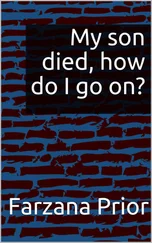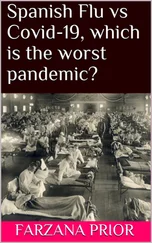The blood bath has begun,
are we too late to save humanity?
BY, Farzana Prior
© 2020 Farzana Prior
All rights reserved.
Author: Farzana Prior
https://www.farzanaprior.com
ISBN: 978-3-98522-933-8
This book is dedicated to my younger son who loves biology.
Now that you have experienced the first pandemic of the twenty first century, are you ready for the next? Humanity is on target to experience pandemic after pandemic since there are thousands of viruses waiting to spill over into humans.
Deforestation is driving wildlife out of their evolutionary niches and into man made environments where they interact and breed new strains of diseases. Three quarters of new diseases that have infected humans recently originated in animals. It is humanity that is encroaching and destroying the habitat of wild species and not the wild species targeting humanity.
When their ecosystem is destroyed, the wild species migrate to new shelters in our homes, sheds or barns. They become stressed in this new shelter and their viruses begin to multiply. So, it’s not the animal’s fault for harbouring these viruses, rather the human is the stressor. Also, the number and variety of viruses in wild animals is higher in those that exist near human habitation than in those that live deep in their untouched ecosystems.
Endangered and threatened species are more likely to harbour viruses than those at lower risk of human destruction. How poorly we treat the forests, has a direct impact on how poorly the viruses in the forests treat us…and humanity is already paying the price with Covid-19.
The next problem is that we place different species that aren’t naturally found together, in nature, in close quarters. The viruses mutate and start to infect other species, like domesticated animals or other wild animals which they get into contact with. These become the intermediary hosts, before the mutated virus makes the next fatal jump to humans.
Long dormant viruses and bacteria trapped in ice and permafrost (frozen soil) are making a fatal comeback as global warming becomes a permanent fixture in humanity’s present and future. Already in 2016, a twelve-year-old boy died and twenty others were hospitalised after being infected with anthrax.
The anthrax originated in an infected reindeer that died over seventy-five years ago, in Siberia, and its carcass became trapped in the permafrost. In the Summer heatwave of 2016, when the permafrost thawed, the infected carcass became exposed and infected the surrounding soil, water and food supply, and people.
Viruses and bacteria that have caused pandemics in the past, can survive for millions of years in the soil of the permafrost. Scientists have discovered Spanish Flu viral fragments in corpses buried in mass graves in Alaska. Smallpox and bubonic plague are also buried in the ice in Siberia, and this means that when the ice in Siberia defrosts, smallpox and bubonic plague will make a comeback.
Tropical diseases such as Dengue fever, Zika, Chikungunya and West Nile viruses are emerging in Europe. The Asian tiger mosquito that carries all four of these viruses can now survive all winter long in coastal areas and river valleys, and is stealthily moving north and is active in the Rhine and Rhône Valleys.

Asian tiger mosquito
Attribution: James Gathany/CDC / Public domain
Further north, in the Baltic, the deadly Vibrio bacteria blooms whenever water surface temperatures rise above fifteen degrees Celsius. Average temperatures are on the rise in higher altitudes and latitudes, meaning ticks can live in new places bringing with them Lyme disease and tick-borne encephalitis (inflammation of the brain).

Ixodes ricinus, spreads Lyme disease and encephalitis
Attribution: James Lindsey at Ecology of Commanster / CC BY-SA (https://creativecommons.org/licenses/by-sa/2.5)
Are we too late? Nature is already backfiring! Let’s call humanity together to make changes toward a common planetary goal…
Politicians: A call to action
Countries are still dependent on coal to provide electricity. Not only are carbon emissions contributing to global warming, but it is also a big contributor to respiratory illnesses, death, crop failure and malnutrition. When coal is burned for electricity, carbon dioxide is released. Carbon dioxide remains in Earth’s atmosphere and absorbs solar radiation, effectively cooking the earth.
Rising temperatures leads to climate change which results in droughts, floods, deadlier hurricanes, heat waves, water shortages, pests and fires. In Australia, the bushfires of 2019-2020 caused a change in weather patterns resulting in dry lightning storms and fire tornadoes.
Humid heat waves are becoming more common despite predictions that this effect is decades away. Humid heat waves are formed when rising temperatures cause increased water evaporation from the ocean. Coastal areas are initially affected, and wind can spread the humid air into the interior.
Humid heat waves are deadly because our bodies use the sweating process to cool down. In the presence of humidity, sweating becomes less efficient. Naturally, these populations would then seek out shade or air conditioning, but what if there is no access to shade or air conditioning? Populations will then be forced to migrate to cooler areas, giving rise to conflict as they move across borders.
High levels of air pollution, caused by burning coal for electricity, is associated with exacerbations of asthma, lung cancer, and heart attacks, including skin allergies. Skin allergies increase when clothing is hung outside to dry and pollutants in the air adhere to these garments, which then irritate the skin when worn. Heart attacks increase because air pollution causes blood to clot. Lung cancers increase because air pollution changes lung tissue DNA.
Deaths are also due to the spread of mosquito borne diseases such as malaria and dengue fever and yellow fever. Vaccines for dengue fever and yellow fever do exist, while the malaria vaccine is being piloted, and aimed at children, because malaria is still the biggest killer of children worldwide.

Anopheles gambiae mosquito spreads Malaria
Attribution: James D. Gathany / Public domain
Deaths are also caused by crop failure. Throughout history, when crops fail, people have been forced to migrate and this triggers conflict. Hot ambient temperatures also cause pests to breed more frequently, which in-turn damage crop and spread diseases.
High carbon dioxide levels reduce the levels of zinc, iron and protein in crops such as wheat, rice, corn and soybean. If populations don’t have access to meat as a food source, these low nutrition crops will exacerbate malnutrition.
If countries continue to burn coal for electricity, they will need to allocate more funding for disease management and disaster management. However, they will not need to if they are proactive. Governments and politicians that are proactive about renewable energy show consideration for the health of the citizens, as well as consideration for our planet. Renewable energy may be perceived as expensive, but it is not as expensive as the funding required for disease management and disaster management.
Читать дальше















